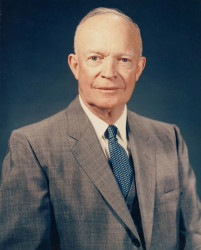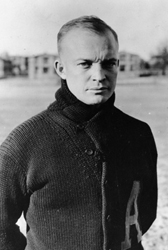Born on October 14, 1890 in Denison, Texas, Dwight D. Eisenhower, the 34th President of the United States.
The greatest hero of World War II as Supreme Commander of the Allied Expeditionary Forces in Europe and architect of America’s victory over Germany, Eisenhower was sought by both political parties, which hoped that he would join their ticket in 1948. President Truman even offered to run in second place as vice president if Eisenhower would join the Democratic ticket. He turned Truman down and then ran as a Republican in 1952, winning the first of two terms.

President Eisenhower (Courtesy: Eisenhower Presidential Library and Museum)
Milestones in Dwight D. Eisenhower’s Life
October 14, 1890 Born in Denison, Texas
1917–1918 Commander, U.S. Army Tank Training School
1932–1935 Senior military assistant to General Douglas MacArthur, U.S. Army chief of staff
1935–1939 Senior military assistant to General MacArthur in the Philippines
1941 Chief of Staff, Third Army
1942 Commanding general, U.S. Forces in Europe
1943–1945 Supreme commander, Allied Expeditionary Forces in Europe
1945–1948 Chief of staff, U.S. Army
1948–1950 President of Columbia University
1951–1952 Supreme commander of NATO Forces in Eu rope
1953–1961 Thirty- fourth president
March 28, 1969 Died at Walter Reed Army Hospital in Washington, D.C., aged seventy- eight. (Eisenhower’s New York Times obituary)

Young Eisenhower at Camp Meade (Photo: US Army, Public Domain Source: Eisenhower Presidential Library and Museum)
The Eisenhower Presidential Library and Museum is located in Abilene, Kansas.
Fast Facts
✱ Eisenhower was the last president born in the nineteenth century.
✱ Ike played army football, but his career was cut short by a broken leg, and so he became a cheerleader instead. No pom-poms.
✱ Eisenhower was the first president to be constitutionally prevented from standing for reelection following ratification of the Twenty-second Amendment; the amendment originated, according to journalist Tom Wicker, “in the Republican Eighty- second Congress as partisan, posthumous revenge against a hated Democrat, Franklin D. Roosevelt, and his four terms.”
✱ The last two of the fifty states were admitted under Eisenhower: Alaska (January 1959) and Hawaii (August 1959).
✱ At seventy, Eisenhower was the oldest president at that time; the youngest elected president, John F. Kennedy, succeeded him.
✱ During his presidency, Eisenhower suffered both a heart attack and a stroke, and was temporarily incapacitated. However, news of both health problems was made public, unlike Woodrow Wilson’s stroke. The Twenty- fifth Amendment, which revised and clarified the rules of presidential succession and allowed for temporary disabilities, was not ratified until 1967, and while Vice President Nixon was acting as executive, he lacked real constitutional authority to do so.
Initially dismissed by historians as a complacent, “do-nothing” president who slept through eight years in office, Eisenhower has moved up the ranks in more recent historical judgments. In Don’t Know Much About® the American Presidents, he received a “A” grade, although he is most faulted for his reluctance to be more forceful in the area of civil rights.
In early October 2014, a planned memorial to Eisenhower in Washington, D.C., which has been the subject of an ongoing controversy over its design, cost and size, received final approval from the National Capital Planning Commission. Conservative columnist George Will calls it a “monstrosity.”
Read more about Eisenhower’s life and administration in Don’t Know Much About® the American Presidents. Eisenhower plays a prominent role in a chapter of my new book, The Hidden History of America at War: Untold Tales from Yorktown to Fallujah (Hachette Books and Random House Audio).

Don’t Know Much About® the American Presidents (Hyperion Paperback-April 15, 2014)

“A fascinating exploration of war and the myths of war. Kenneth C. Davis shows how interesting the truth can be.” –Evan Thomas, New York Times-bestselling author of Sea of Thunder and John Paul Jones